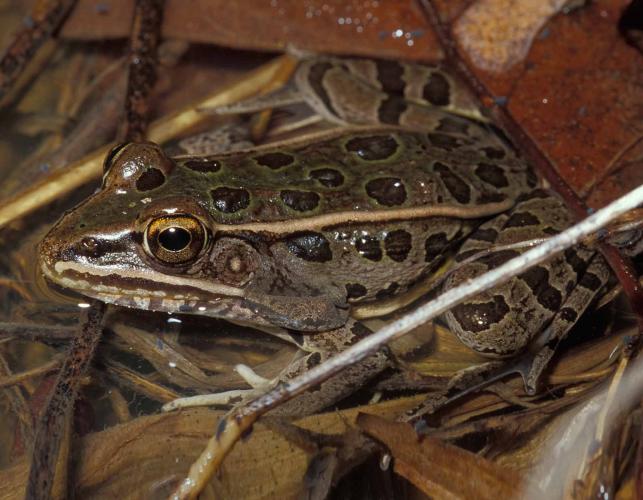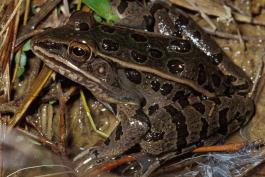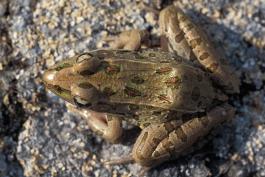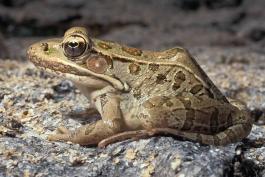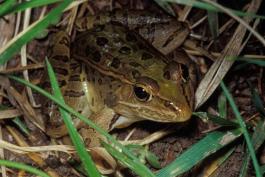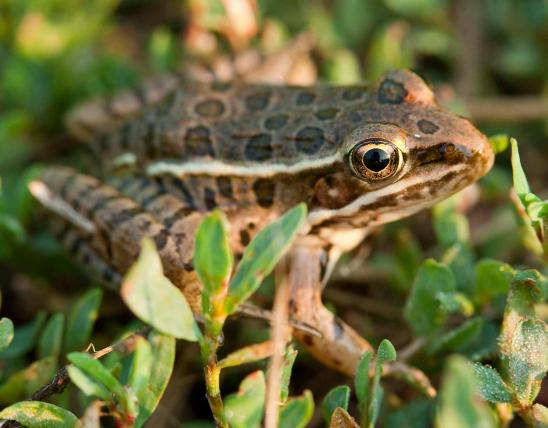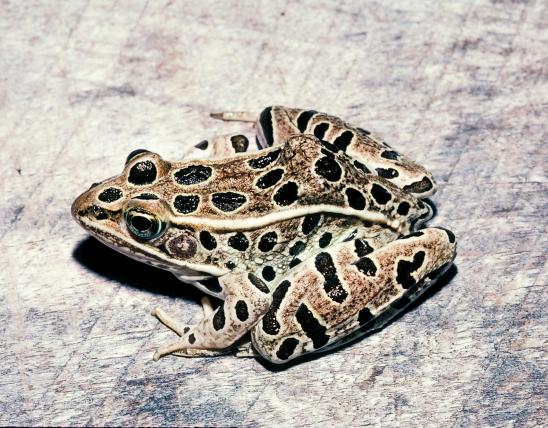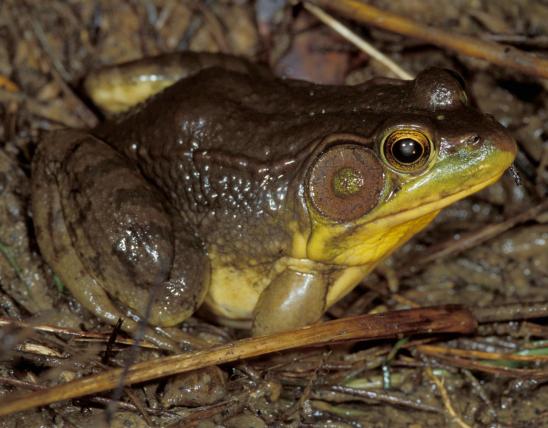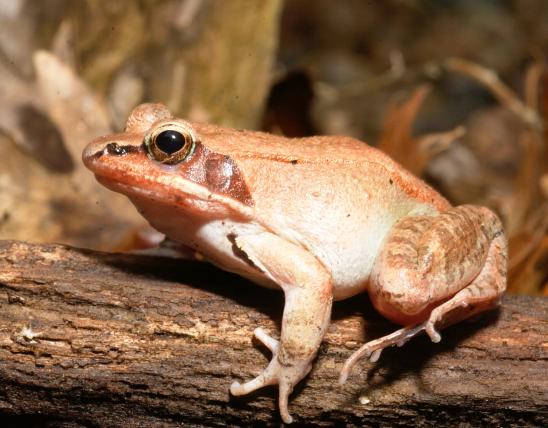
The southern leopard frog is a medium-sized frog with dark, rounded or oblong spots on the back. The two folds along the sides of the back are narrow, distinctly raised, yellow or tan, and run continuously to the groin. The head looks long and the snout is pointed. The general color is green, greenish brown, or light brown with some green on the back. The dark marks on the hind legs are broken bars or elongated spots. There is usually no dark spot on the snout. A white line is present along the upper lip. The center of the tympanum (round, external ear) usually has a distinct white spot. The belly is white.
The male's call is a series of abrupt, chucklelike quacking sounds, repeated at a rate of 12 pulses per second.
Similar species: The southern leopard frog differs from our other leopard frogs and the pickerel frog by its narrow, continuous dorsolateral fold, pointed snout, usual lack of a snout spot, lack of yellow along the groin and inner thighs, and absence of white rings around the spots on the back.
In some parts of Missouri, the ranges of the the southern leopard frog and plains leopard frog overlap, and hybridization with these two species may occur. This is especially likely in places where habitats have been altered due to human activity. When a breeding habitat is changed, the environmental barriers that would normally isolate species during their breeding season are lost, and hybridization may occur.
Missouri has eight members of the true frog family. These are typically medium to large frogs with long legs, smooth skin, and well-developed webbing between the hind toes. Another common characteristic is a glandular fold or ridge of skin along each side of the back (these are called dorsolateral folds).
Adult length (snout to vent): 2–3½ inches; occasionally to 5 inches.
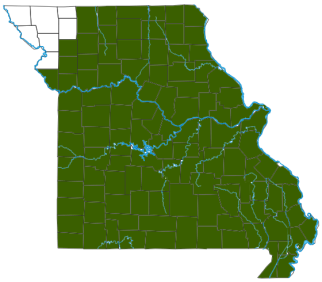
Throughout most of Missouri except for the northwestern corner of the state.
Habitat and Conservation
In summer, southern leopard frogs may venture far from water into pastures, meadows, or woods where they hunt for insects.
When near an aquatic habitat, leopard frogs sit at the water’s edge but quickly enter the water with a powerful jump if alarmed.
Southern leopard frogs use a wide variety of aquatic habitats, including creeks, rivers, sloughs, swamps, marshes, ponds, lakes, and flooded ditches. Because water evaporates from their bodies easily, these frogs must remain near water or use burrows of mammals and crayfish to escape hot summer conditions. Recently transformed adults will actively burrow into the substrate or use existing burrows to avoid losing water during droughts.
Food
Southern leopard frogs eat a variety of insects and other invertebrates.
Status
Widespread and quite common in Missouri.
Taxonomy: The true frog family (Ranidae) is the largest and most widespread family of frogs. It contains 365 species in 14 genera and probably originated in Africa. Representatives of this cosmopolitan family occur on every major land mass except New Zealand, Antarctica, most oceanic islands, the West Indies, and southern South America. The largest genus in the family in the New World (North and South America) is Lithobates (formerly Rana), with about 50 species. Missouri’s species, formerly in genus Rana, are all in genus Lithobates. As of taxonomic understandings in 2016, the Rana genus is considered restricted to the eastern hemisphere and western North America. In Missouri, the genus Lithobates is represented by eight species.
Life Cycle
In our state, this species is normally active between late February and mid-October, and breeding can occur from late winter into fall. Adults migrate to breeding ponds in spring, where they call and breed. The peak for calling is from early March into July. The peak of breeding is from mid-March to mid-May.
Ponds, sloughs, and flooded ditches are the breeding sites. Several thousand eggs are laid in several clumps or masses, which are loosely attached to submerged sticks or stems. Eggs hatch within 2 weeks, varying with water temperature. Because of the long breeding season, southern leopard frog tadpoles can be found metamorphosing from mid-June to September.
Sometimes this species breeds during the autumn and the tadpoles overwinter in the breeding wetland.
Human Connections
Missouri’s anglers sometimes use southern leopard frogs as live bait (daily limits apply, however; check current fishing regulations to make sure you’re using them legally).
Many Missourians enjoy observing these attractive frogs as they plop into the water and sing their courting calls.
Ecosystem Connections
This species preys on a variety of insects and spiders and is in turn preyed upon by ribbonsnakes, gartersnakes, and other predators. The eggs and tadpoles become food for many wetland predators.
Surveys in Missouri have revealed that the number of southern leopard frogs calling is highly influenced by weather conditions. During the 2012 drought in Missouri, very few southern leopard frogs were heard calling across the state, but they readily rebounded the following wet years.






